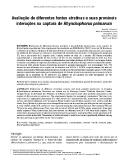Avaliacao de diferentes fontes atrativas e suas prováveis interacoes na captura de Rhynchophorus palmarum
Alternative title
Evaluation of different attraction sources and their possible interaction in trapping Rhynchophorus palmarum Evaluación de diferentes fuentes atractivas y sus probables interacciones en la captura de Rhynchophorus palmarum
Description
3 ilus. 7 tab. 15 ref.
Abstract
Este experimento fue conducido por EMBRAPA CPATC, Aracaju/SE, Brasil, con el objetivo de evaluar la eficiencia de diferentes fuentes de atracción y sus probables interacciones en la captura de adultos de Rhynchophorus palmarum. Las fuentes de atracción caña de azúcar (C), feromona de agregación (F), con y sin cambio de la cápsula cada 3 meses, acetato de etila (A) y melaza (M) fueron evaluadas separadamente, y combinadas de dos en dos y de tres en tres, sumando 12 tratamientos en total. Las tiras atractivas fueron colocadas en trampas confeccionadas con baldes plásticos de 50 litros. Las trampas fueron evaluadas y cambiadas de lugar en cada colecta para reducir la influencia del lugar sobre el estímulo del insecto. Un total de 6365 adultos fueron recolectados durante el período experimental. Los tratamientos T10 y T8 fueron los más eficientes en la captura de los insectos con 30,54 por ciento y 19,28 por ciento, respectivamente, del total de adultos recolectados. Utilizados aisladamente, los atractivos no fueron eficientes, sumando apenas 4,76 por ciento de los insectos recolectados, mostrando que la interacción de las fuentes atractivas es necesaria para un mayor efecto sinérgico en la atracción de R. palmarum. El número de las capturas en cada tratamiento no fue significativamente diferente en relación con el lugar de captura. Research was carried out by Embrapa Coastal Tableland Research Center, Sergipe, Brazil, to determine the efficiency of different lures and to study their probable interaction in the capture of Rhynchophorus palmarum. The experimental design was completely randomized. The lures were sugar cane (C) aggregation pheromone (F) ethyl acetate (A) and molasses (M), tested alone, and combined in twos and threes, adding up to 12 treatments. Plastic bucket traps (50 liters capacity) were used to catch the adults. Every fifteen days, the traps were changed from site to site to avoid the spot effect on the weevil capture. A total of 6365 adults of R. palmarum were captured during the experimental period. The treatment T10 and T8 were the most efficient ones. They were able to attract 30.54 percent and 19.28 percent, adults, respectively, from total adults captured. When tested alone, the lures showed an efficiency level of 4.76 percent from total captures. This result shows the importance of interaction between lures to promote a synergistic effect on the attraction of R. palmarum adults in the field. The number of adults attracted by each lures was not significantly different among the sites, showing no spot effect on the weevil capture.
Keywords
Publisher
Centro Agronómico Tropical de Investigación y Enseñanza (CATIE), Turrialba (Costa Rica)
URI (Permanet link to cite or share this item)
https://repositorio.catie.ac.cr/handle/11554/6260Collections
- Publicaciones y documentos [4419]


